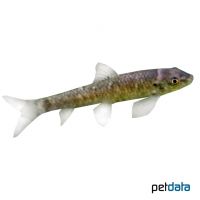Red Garra (Garra rufa)
| Red Garra Garra rufa | |
|---|---|
| Name | Red Garra |
| Name Lat. | Garra rufa |
| Family | Carps |
| Family lat. | Cyprinidae |
| Order | Carps |
| Order lat. | Cypriniformes |
| Origin | Asia Minor |
| Habitat | Streams, rivers, ponds |
| Diet | Limnivore |
| pH | 6.0-8.0 |
| Behavior | Peaceful |
| Keeping | Group |
| Care Level | Moderate |
| Reproduction | Egg scatterer |
| Breeding | Moderately difficult |
| Life Span | 2-5 years |
| Protection | No |
| Metric Units | |
| Size | 14 cm |
| Temperature | 15-28 °C |
| Hardness | 8-15 °dH |
| Aquarium | 200 l |
| US Units | |
| Size | 5.5" |
| Temperature | 59-82 °F |
| Hardness | 142-267 ppm |
| Aquarium | 50 gal |
Distribution and habitat
The distribution area of the reddish sucker barb is Asia Minor. There they live in the shallow waters of tributaries, streams, lakes and ponds, as well as in outflows of thermal springs, usually hidden under stones and in dense vegetation.
Maintenance
The aquarium should be structured with stone structures (caves), boulders and roots as well as free sand areas and have dense planting in places. A substrate of sand or fine gravel, oxygen-rich water and a weak current is ideal.
No ammonia, ammonium and nitrite should be detectable, the nitrate value should not exceed 100 mg/l. To ensure the water quality and oxygen content, a filter and heater adapted to the aquarium size is required, as well as lighting for the species-appropriate day-night rhythm of the animals.
Diet
They eat the vegetable cover (growth) of stones, wood, plants, etc. and the microorganisms contained therein. For a balanced diet, feed them once a day with a high-quality sinking dry food (granules, tablets) as well as cyclops, daphnia or mosquito larvae (live or frozen). In addition, they need vegetable food, such as crushed peas, scalded spinach, zucchini slices or algae leaves.
Only feed as much as will be eaten within a few minutes. A regular and varied diet promotes health and increases resistance.
Behaviour and compatibility
They are sociable and peaceful fish that should be kept in a group of at least 5, but preferably more. A socialization with other peaceful fish, such as small danios or loaches is very well possible
Basically, only compatible fish species with similar demands on water conditions and water temperature should be socialized.
Sex dimorphism
Males remain more slender, have longer pectoral fins and a stronger spawning rash than females.
Reproduction and breeding
They are free spawners that spawn over gravel bottom. After 36-48 hours the young hatch. Their yolk sac is used up after about 4 days and they swim freely.
Juveniles must be fed several times a day with special rearing food (Artemia nauplii). In community tanks breeding is hardly possible, because the young fish are easy prey.
Important
A locality form, which comes from warm springs near Kangal in Turkey and has become known as "Kangal or nibbling fish" is used to treat skin diseases in humans, such as neurodermatitis, psoriasis or eczema. They nibble dead skin from the patient and in the process enzyme-containing secretion is said to penetrate the small wounds
The well-being of the fish should be checked regularly. Temperature should be checked daily, pH, hardness and nitrate levels should be checked at least every 14 days. Regular partial water changes are recommended, even if the contaminant level has not yet reached the upper limit. Sudden changes in water quality should be avoided. Newly introduced fish must be accustomed slowly to the water in the aquarium.
Further literature can be found in your pet store.
References
Text: Werner Winter; Image: petdata
Source: BMELV (1998): Tierschutzgutachten - Haltung von Zierfischen (Süßwasser); RIEHL & BAENSCH (2004): Aquarien Atlas Bd. 3, Mergus Verlag; ENGELMANN (2005): Zootierhaltung - Tiere in menschlicher Obhut: Fische, Verlag Harri Deutsch
- Gemäß § 21 Abs. 5 Tierschutzgesetz idgF
